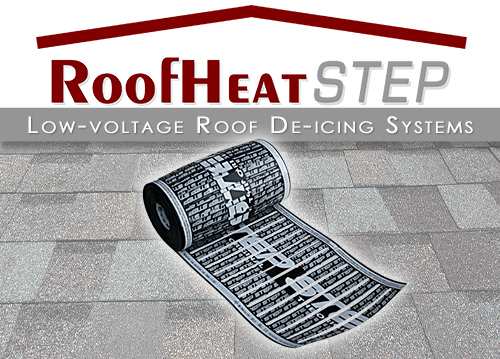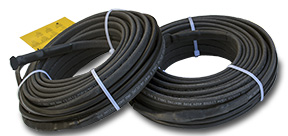The single most common – and costly – roof problem caused by snow and ice is that of the ice dam. While a roof de-icing system can help to prevent ice dams from forming, it’s important for homeowners to also be aware that the major cause of ice dams is a poorly insulated attic. In other words, the first step in caring for your roof is to ensure that your attic is ventilated and well insulated.

Poorly insulated attics allow heat to escape and warm the roof above. As this happens, the bottom layer of snow melts. The runoff trickles down to the eaves, but because no warmth from the attic reaches the eaves, the roof edges are significantly colder, and oftentimes the runoff refreezes at it approaches the roof’s edge. This frozen water creates a small ridge, and over time additional runoff can repeat this process and the ice ridge increases in size. Eventually, water pools behind the ridge of ice, and this is where the problems can start.
Standing pools of water on a roof allow water to seep into every nook and cranny. As that water refreezes at night, it expands and accentuates every tiny crack or flaw in the roof. Eventually water may even find a way to seep inside the home. This can lead to water and mold damage; two things a homeowner never wants to hear about or deal with.
Warmzone’s low-voltage RoofHeat STEP® de-icing system may be the industry’s best solution for preventing ice dams by keeping roof edges clear of snow and ice. This self-regulating system features thin, 12-inch wide polymer heating panels (different widths are also available) that are installed discreetly under the roof shingles. Because it is self-regulating, when the ambient temperature rises, the electrical resistance increases, resulting in the consumption of electricity to decrease. This helps to ensure energy-efficient operation and prevent the element from overheating. The durable heating element is polypropylene fused during fabrication to achieve water proofing and protection from alkaline or salt damage. The low-voltage RoofHeat STEP system can also be safely installed under metal roofs. The flexible element can be nailed and stapled through, facilitating the installation process.

The system utilizes transformers to step down high voltage to low voltage (60 volts or less). Individual control boxes monitor the power and output to the heating element to ensure safe, accurate, efficient performance. Installing this system along the roof eaves and in valleys is an ideal way to protect your roof by ensuring runoff and preventing ice dams. Looking at your roof from the street, with the exception of the melted snow, you can’t even tell that you have a de-icing system installed on your roof.
Warmzone's low-voltage roof heating systems are also fully automated. The system uses the STEP "TOUCH" thermostat, but can also use other advanced snow sensors from Warmzone. Automated snow sensors detect precipitation and temperature. When weather conditions warrant, the sensor activates the system. When the first flakes of a snowstorm are detected, and the temperature is below the adjustable set point, the sensor sends a signal to the system's controller. (The compact controller is usually mounted on a wall in the garage.) After being triggered by the snow sensor, power is then sent to the heating element to begin warming the roof, ensuring that there is no snow or ice buildup.
The most popular thermostat used with the RoofHeat STEP de-icing system is the TOUCH thermostat with simple two-control functionality for ease of operation. This sleek, compact controller features a 3-digit, auto-dim LED display, and is designed to work seamlessly with all Warmzone radiant heat systems, including snow melting, roof de-icing, and floor heating systems. It is also capable of interfacing with smart home systems. Another advanced feature allows all of the thermostat’s settings to be stored in permanent memory, which can be instantly recovered in the event of a power failure. No batteries are needed.

Another option to combat ice dams, as well as to keep gutters and downspouts ice free, is to install self-regulating heat trace cable. This is perhaps the most affordable roof de-icing option. The cable is typically zigzagged along the roof edges to provide channels for the runoff, effectively dismantling the threat posed by ice dams. To protect gutters in Sun Valley from heavy ice damage and facilitate runoff, the heat cable is routed directly through the gutters and downspounts. In addition to being so affordable, this popular roof de-icing solution can be easily customized to provide effective de-icing for virtually any problem area on roofs, and can also be used in pipe trace applications.
Call Warmzone today to learn more about your roof heating options. In addition to a wide selection of custom options, Warmzone also includes free installation training, comprehensive system design and layout, and technical installation support. Our radiant heat experts stand ready to assist you if you have any questions during the installation. Call 888.488.9276 today. You can also Email us or fax us (801.948.7599) a plan or sketch of your roof, and we'll be happy to provide you with a free quote for the best de-icing option for your budget. Feel free to visit our FREE quote form to fill out your information and submit it to receive a free quote. We look forward to hearing from you.